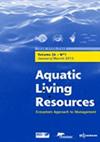Age, growth and maturity of frigate tuna (Auxis thazard Lacepède, 1800) in the Southeastern Brazilian coast
IF 1.9
4区 农林科学
Q3 FISHERIES
引用次数: 0
Abstract
Age, growth and maturity of frigate tuna (Auxis thazard) were studied for the first time in Southeast Brazil. A total of 650 fish (265–494 mm Fork Length) were sampled from beach-seine landings between March 2018 and February 2019. Sectioned fin spines from 548 specimens were processed and age was determined by counting and measuring of increments. Growth parameters were fitted to length-at-age data using the von Bertalanffy growth function and were compared to the literature using the growth performance index (Phi). Macro and microscopic characterization of gonads and physiological indexes were used for the analysis of the reproductive cycle. The length distribution did not differ by sex. Assigned ages were between 0+ and 4 years, with annual increments formed during winter. Coefficient of variation between readings was 11%. Growth differed by sex, and the von Bertalanffy growth parameters were L∞ = 471 mm; k = 0.47 year−1; and t0 = –1.46 year−1 for females; L∞ = 498 mm; k = 0.35 year−1; and t0 = –2.01 year−1 for males. Phi was 5.0 for both sexes. Estimated growth rate is among the lowest recorded for the species, possibly related to the method used for age and growth assessment. Gonadosomatic index peaked in December, associated with the upwelling of the South Atlantic Central Waters, at a temperature of approximately 16 °C. Spawning activity in colder waters has never been reported for this species and may be influenced by a richer habitat caused by the intrusion of more nutritive rich waters during spring-summer, which allows larval development. Length-at-first-maturity (L50) was 345.4 mm for females and 329.8 mm for males.
巴西东南海岸护卫舰金枪鱼的年龄、生长和成熟(Auxis thazard lacep, 1800)
在巴西东南部首次对护卫舰金枪鱼(Auxis thazard)的年龄、生长和成熟度进行了研究。在2018年3月至2019年2月期间,共从海滩围网上岸的650条鱼(叉长265-494毫米)取样。对548个标本的鳍刺切片进行了处理,并通过计数和测量增量来确定年龄。使用von Bertalanffy生长函数拟合生长参数与年龄长度数据,并使用生长性能指数(Phi)与文献进行比较。利用性腺的宏观和微观特征及生理指标分析其生殖周期。长度分布没有性别差异。分配年龄在0 ~ 4岁之间,在冬季形成年度增量。读数之间的变异系数为11%。生长存在性别差异,von Bertalanffy生长参数为L∞= 471 mm;K = 0.47 year−1;女性t0 = -1.46 year - 1;L∞= 498 mm;K = 0.35 year−1;男性t0 = -2.01 year - 1。男女的Phi值都是5.0。估计的生长率是该物种的最低记录之一,可能与用于年龄和生长评估的方法有关。促性腺指数在12月达到峰值,与南大西洋中部水域上升流有关,温度约为16°C。该物种在较冷水域的产卵活动从未报道过,可能受到春夏期间营养丰富的水域入侵造成的更丰富栖息地的影响,这有利于幼虫的发育。初熟体长(L50)雌性为345.4 mm,雄性为329.8 mm。
本文章由计算机程序翻译,如有差异,请以英文原文为准。
求助全文
约1分钟内获得全文
求助全文
来源期刊

Aquatic Living Resources
农林科学-海洋与淡水生物学
CiteScore
2.30
自引率
0.00%
发文量
10
审稿时长
>24 weeks
期刊介绍:
Aquatic Living Resources publishes original research papers, review articles and propective notes dealing with all exploited (i.e. fished or farmed) living resources in marine, brackish and freshwater environments.
Priority is given to ecosystem-based approaches to the study of fishery and aquaculture social-ecological systems, including biological, ecological, economic and social dimensions.
Research on the development of interdisciplinary methods and tools which can usefully support the design, implementation and evaluation of alternative management strategies for fisheries and/or aquaculture systems at different scales is particularly welcome by the journal. This includes the exploration of scenarios and strategies for the conservation of aquatic biodiversity and research relating to the development of integrated assessment approaches aimed at ensuring sustainable and high quality uses of aquatic living resources.
 求助内容:
求助内容: 应助结果提醒方式:
应助结果提醒方式:


